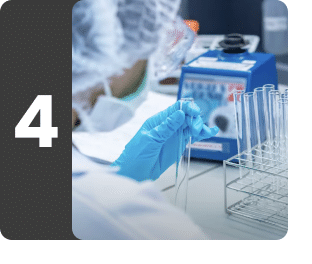Peri-Menopausal Panel Advanced near me in Bangalore
Understanding Peri-Menopausal Panel Advanced in Bangalore
What is Peri-Menopausal Panel Advanced in Bangalore?
Perimenopause is the time when a woman's body is going through hormonal changes just before menopause (end of the menstrual cycle). The peri-menopausal panel advanced package is tailored to detect the levels of hormones regulating the menstrual cycle in women and also helps to determine the onset of menopause. This package offers a lipid profile, hormone test (estradiol, free thyroid profile, follicle-stimulating hormone, and anti-mullerian hormone), blood sugar test, calcium test, phosphorus test, and serum albumin test. This package can be used by women who have symptoms like irregular periods, vaginal dryness, sleep problems, hot flashes, anxiety, and depression. This package will help you to make lifestyle changes to lead a healthy life and prevent complications associated with perimenopause.
What does Peri-Menopausal Panel Advanced measure?
Contains 18 tests
Follicle Stimulating Hormone
Follicle-stimulating hormone (FSH) is a hormone which is associated with reproduction and the development of eggs in women and sperm in men. This test measures FSH in the blood.
FSH is produced by the pituitary gland, and its production is controlled by a feedback system involving the hypothalamus in the brain, the pituitary gland, and the hormones produced by the ovaries or testicles. The Gonadotropin-releasing hormone (GnRH) from the hypothalamus stimulates the pituitary gland to release FSH and luteinizing hormone (LH; another closely-related hormone also involved in reproduction). FSH affects the growth and maturation of egg follicles in the ovaries during the follicular phase of the menstrual cycle. The menstrual cycle is divided into follicular and luteal phases, each phase lasting for 14 days. During the follicular phase, FSH initiates the production of estradiol by the follicle, and the two hormones work together in the further development of the egg follicle. Near the end of the follicular phase, the production of FSH and luteinizing hormone increases. The release of the egg from the ovary (ovulation) occurs shortly after this increased production of hormones. The hormone inhibin as well as estradiol and progesterone help control the amount of FSH released by the pituitary gland. FSH also facilitates the ability of the ovary to respond to LH. At menopause, ovarian function decreases and eventually ceases which results in increased levels of FSH and LH.
In males, the role of FSH is to stimulate the testicles to produce mature sperms and also promotes the production of androgen binding proteins. FSH levels are relatively constant in men after puberty than in women.
In infants and children, FSH levels rise shortly after birth and then fall to very low levels by 6 months in boys and 1-2 years in girls. Concentrations begin to rise again before the beginning of puberty and the development of secondary sexual characteristics.
Disorders affecting the hypothalamus, pituitary, and/or the ovaries or testicles can cause the production of too much or too little FSH, resulting in a variety of conditions such as infertility, abnormal menstrual cycles, or early (precocious) or delayed sexual maturation (puberty).
Know more about Follicle Stimulating Hormone

Phosphorus, Serum
Ph, Serum measures the levels of inorganic phosphates in blood. It is critical in the production and storage of energy as it forms a part of the energy currency of cells (Adenosine tri, di, and monophosphates). It is also a structural component of DNA. It is essential in the functioning of nerves and muscles, and in the growth and maintenance of healthy bones. In blood, phosphates act as buffers to maintain the pH and electrolyte balance of the body.
The main source of phosphorus comes from diet. Once consumed, it is quickly absorbed by the digestive system. In the body, most of the phosphates are bound to calcium in the bones and teeth. Some of it is found in muscles and nerves, and a small amount is present in cells, where it forms a structural component of DNA. Very small amounts of phosphates are normally found in circulation, and these levels are measured with blood phosphorus levels.
Phosphate levels in the blood are maintained within its very narrow normal concentration range by excretion of excess phosphorus through kidneys. Phosphate levels are also dependent on the levels of calcium, Vitamin D and parathyroid hormone in blood.
Know more about Phosphorus, Serum

Calcium
Calcium (Ca) Test measures the levels of calcium in blood. Calcium is essential for body processes including cell signaling, blood clotting, contraction of muscles, and functioning of nerves. It plays a crucial role in the formation and maintenance of healthy bones. Deficiency of calcium results in Osteoporosis, a disease in which the bones lose their density and become soft and fragile, causing them to fracture very easily.
About 99% of the total amount of calcium received by the body is bound as calcium complex in bones, and the remaining 1% lies in blood circulation. Of the amount of calcium circulating in the blood, about half remains bound to albumin protein or other ions and are metabolically inactive, while the remaining half remains free and metabolically active. Blood Calcium tests can be of two types: Total Calcium Test used to measure the total calcium concentration in blood including both the free and bound forms, and Ionized Calcium Test used to measure the concentration of only the metabolically active form.
Calcium levels in the blood are maintained within a very narrow range by a number of mechanisms. Deviation from the normal range of calcium concentration causes Hypocalcemia (low levels of calcium), or Hypercalcemia (excess of calcium). Both these conditions impact normal body processes in the short term and may give rise to other conditions in the long term.
A blood calcium test cannot be used to check for a lack of calcium in your diet or for osteoporosis (loss of calcium from bones) as the body can have normal calcium levels even in case of dietary deficiency of Calcium. The body can augment mild calcium deficiency by releasing the calcium stored in bones.
Know more about Calcium

Anti-Mullerian Hormone
The AMH Test measures the levels of Anti Mullerian Hormone or AMH in blood.
Anti Mullerian Hormone or AMH is produced primarily by the testicles in males and the ovaries in females. AMH levels in blood determine and regulate a number of activities of the human reproductive system.
In the first few weeks of the fetal development during pregnancy, the fetus has both the primordial male and female reproductive systems and can develop either as a male or a female. In genetic males, high amounts of AMH are secreted by the testicles, suppressing the formation and development of the female reproductive organs from Mullerian ducts (primordial female reproductive system), and encouraging the development of other male sex organs, which results in the development of a male child. Low or no AMH secreted in the genetically female fetus causes the formation and development of female reproductive organs from the Mullerian duct and a female child is developed. Abnormalities of AMH levels in the fetus may cause the formation of ambiguous genitalia.
After birth, AMH levels remain high in males till puberty, after which they fall slowly and taper off with time. AMH levels in females remain low after birth till puberty. During puberty, AMH is secreted by the ovaries resulting in a sharp increase in its levels. The levels slowly keep falling throughout the female reproductive period and become very low to undetectable after menopause. AMH maintains a balance of the two important female reproductive hormones: Luteinizing Hormone (LH) and Follicle Stimulating Hormone (FSH), which regulate the maturation and release of eggs from the ovaries along with other hormones. Hence, AMH levels during the female reproductive period serve as an indication of the ovarian reserve (number of remaining eggs that can mature fully and be released for reproduction), and hence fertility. It is also an indicator of the onset of menopause, especially in older women.
AMH can also be produced by ovarian cysts formed during PCOS, as well as by some types of ovarian tumors.
Know more about Anti-Mullerian Hormone

Thyroid Profile Free
The Thyroid Profile Free Test measures the levels of the following three hormones in the blood:
Thyroid Stimulating Hormone (TSH)
Thyroxine (T4) - Free
TriIodothyronine (T3) - Free
The thyroid gland (a small, butterfly-shaped gland located in front of the neck) secretes the following hormones:
Triiodothyronine (T3)
Thyroxine (T4)
Thyroid Stimulating Hormone (TSH) is a hormone secreted into the blood by Pituitary gland (a gland present in the brain). It directs thyroid gland to produce and release the thyroid hormones (T3 & T4) into the blood. The iodine from the food stimulates the thyroid gland to make the thyroid hormones.
The thyroid hormones regulates the growth and metabolism of the body. If the thyroid gland produces very high amounts of these hormones (T3 and T4), you may experience symptoms of weight loss, rapid heartbeat, tremors, sweating, anxiety, increased sensitivity towards heat, etc. and this is known as Hyperthyroidism.
The decreased production of thyroid hormones (T3 and T4) results in Hypothyroidism which may cause weight gain, fatigue, slow heart rate, increased sensitivity towards cold, depression, dry and thin hair, etc.
There is a feedback system in the body to maintain stable amounts of the thyroid hormones (T3 and T4) in the blood. When the levels of thyroid hormones decrease, the pituitary gland is stimulated to release TSH. High TSH in turn increases the release of T3 and T4 hormones from the thyroid gland and vice-versa.
T3 and T4 circulate in the blood in two forms:
1) Bound form - It is bound to proteins present in blood and this prevents it from entering the body tissues. The three main proteins in the blood that the thyroid hormones are bound to are albumin, transthyretin and Thyroxine-binding globulin (TBG), also called Thyroid hormone Binding Globulin (THBG).
2) Free form - It enters the body tissues where it is needed.
The total T3 or total T4 includes both the bound and the free forms circulating within the blood. Hence, thyroid hormones can be measured as Free T3, Total T3, Free T4 and Total T4.
The Thyroid Profile Free Test measures the free forms of T3 and T4 i.e. FT3 and FT4 along with TSH.
Know more about Thyroid Profile Free
This further contains
- Thyroxine - Free
- Triiodothyronine Free
- Thyroid Stimulating Hormone, Ultrasensitive

Glycosylated Hemoglobin
Glycosylated Hemoglobin Test measures the percentage of glycosylated hemoglobin in blood which reflects the average blood glucose over a period of past two to three months (8 - 12 weeks).
Hemoglobin is the protein found in Red Blood Cells and is responsible for transporting oxygen. Of the different types of hemoglobin, Hemoglobin A is predominant. With the elevation of blood sugar levels, some glucose binds spontaneously to Hemoglobin A (this binding is called Glycosylation or Glycation) and remains bound for the complete lifetime of the RBC, which is 120 days normally. Higher the level of glucose in the blood, greater is the amount of it binding to Hemoglobin A. Hemoglobin A1c is the dominant form of Glycated Hemoglobin. As RBCs die and are replaced, Hemoglobin A1c is cleared and slowly replaced with non-glycosylated hemoglobin. Measurement of HbA1c level over a period of time gives an indication of the level of glucose in the blood over the specified period of time. This helps in the diagnosis of Diabetes and is useful for monitoring the effectiveness of measures taken to reduce blood sugar levels.
Know more about Glycosylated Hemoglobin

Serum Albumin
The serum albumin test measures the levels of albumin present in the blood. Albumin is a protein which is made by the liver. This protein makes up about 60% of the total protein in the blood and has various functions.
The role of albumin is to keep fluid from leaking out of blood vessels and give nourishment to tissues. It also helps in the transportation of hormones, vitamins, calcium, and other substances throughout the body. The levels of albumin protein may decrease if there is any interference in its production from the liver. These decreased levels can be due to other reasons such as increase in the breakdown of proteins, increase in loss of proteins via the kidneys, and in case there is blood dilution (expansion of plasma volume).
The main causes of low albumin protein include severe liver disease and kidney disease.
Know more about Serum Albumin

Lipid Profile
The Lipid Profile Test typically measures the levels of total cholesterol, HDL cholesterol, LDL cholesterol, and triglycerides. Other results that may be reported include VLDL cholesterol, non-HDL cholesterol, and total cholesterol to HDL cholesterol ratio.
Lipids are fatty acids which store energy for the body and play essential roles in cellular structure and cell signaling. Cholesterols and triglycerides are essential lipids, carried in the blood by lipoprotein particles made up of cholesterol, triglycerides, proteins and phospholipid molecules. The lipoprotein particles are classified according to their densities into High Density Lipoproteins (HDL), Low Density Lipoproteins (LDL), and Very Low Density Lipoproteins (VLDL).
Cholesterol is a fat-like substance formed in the liver, as well as obtained from dietary sources. It is found in all the cells and is an essential part of the structural framework of the cells apart from performing various vital body processes. However, excess cholesterol is harmful. Increased cholesterol in blood can cause it to get deposited on the inner walls of the blood vessels forming plaque.
Triglycerides are the commonest type of fat in the body. Triglycerides are obtained from dietary sources and form the stored fat in adipose tissues. Increase in triglyceride concentration can also give rise to cardiovascular diseases.
High Density Lipoproteins or HDLs are high density particles which help to reduce the chances of cardiovascular diseases by picking up and carrying lipoprotein particles of lower density to the liver for disposal.
Low Density Lipoproteins or LDLs are lipoprotein particles of low density which carry cholesterol to the tissues. Cholesterol carried by LDLs easily comes out of blood and get deposited on the inner walls of the blood vessels, increasing the chances of cardiovascular diseases.
Very Low Density Lipoproteins or VLDLs are lipoprotein particles of very low density which carry triglycerides to the tissues. Excess triglycerides in blood causes increase in VLDL particles which in turn again increases the chance of developing cardiovascular diseases.
Plaque deposition makes the lumen of the blood vessels narrower thereby preventing proper flow of blood and may stop the flow completely. Excessive plaque deposition can also cause the arteries to harden, giving rise to a condition called Atherosclerosis. Improper flow of blood prevents the supply of nutrients and oxygen to the vital organs and may cause heart attack or stroke.
Know more about Lipid Profile
This further contains
- Cholesterol - LDL
- Triglycerides
- Cholesterol - Total
- Cholesterol - HDL
- Very Low Density Lipoprotein
- Total Cholesterol/HDL Cholesterol Ratio
- LDL/HDL Ratio
- Non HDL Cholesterol

Estradiol Test
Estradiol test measures the levels of estradiol in blood. Estradiol is a form of estrogen hormone which plays an important role in the function and development of reproductive organs and in the formation of secondary sex characteristics in females. It regulates the menstrual cycle in women along with progesterone. Other functions of estrogen along with progesterone include the growth of breasts and uterus. Estrogen hormone is also found in men. It regulates growth and metabolism in both males and females. In men, estradiol is produced in testicles while in pre-menopausal women it is produced in ovaries. In postmenopausal women, estradiol is converted into estrone. Estradiol is present in high levels in non-pregnant and pre-menopausal women. Depending upon the age of the women and her reproductive status the values of estradiol varies. It is considered to be one of the good markers as regards to ovarian function.
At birth, the levels of estradiol are high but the levels fall within a few days and become minimal during early childhood. As puberty approaches the levels of estradiol rise. During the menstrual cycle, its levels vary depending upon the ongoing menstrual cycle phase. During menopause, the levels of estradiol fall as the production by ovaries decreases.
Know more about Estradiol Test
Book a Peri-Menopausal Panel Advanced test at home near me





Other tests









